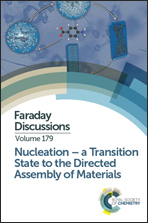Recent advances in the understanding of two-step nucleation of protein crystals
Abstract
The two-step mechanism of nucleation of crystals in solutions posits that the formation of crystal nuclei occurs within structures of extended lifetimes, in which the nucleating solute is at high concentration. The validity of this mechanism has been demonstrated for proteins, small-molecule organic and inorganic materials, colloids, and polymers. Due to large molecule sizes, proteins are an ideal system to study the details of this nucleation pathway, in particular the formation mechanisms of the nucleation precursors and the associated physico-chemical rules. The precursors of protein crystal nuclei are protein-rich clusters of sizes ∼100 nm that contain 10 000–100 000 molecules and occupy less than 10−3 of the total solution volume. Here we demonstrate, using oblique illumination microscopy, the liquid nature of the clusters of the protein lysozyme and reveal their inhomogeneous structure. We test a hypothesis put forth by theory that clusters primarily consist of transient protein oligomers. For this, we explore how varying the strength of the Coulomb interaction affects the cluster characteristics. We find that the cluster’s size is insensitive to variations of pH and ionic strength. In contrast, the addition of urea, a chaotropic agent that leads to protein unfolding, strongly decreases the cluster size. Shear stress, a known protein denaturant, induced by bubbling of the solutions with an inert gas, elicits a similar response. These observations support partial protein unfolding, followed by dimerization, as the mechanism of cluster formation. The amide hydrogen–deuterium exchange, monitored by nuclear magnetic resonance, highlights that lysozyme conformational flexibility is a condition for the formation of the protein-rich clusters and facilitates the nucleation of protein crystals.
- This article is part of the themed collection: Nucleation – a Transition State to the Directed Assembly of Materials

 Please wait while we load your content...
Please wait while we load your content...